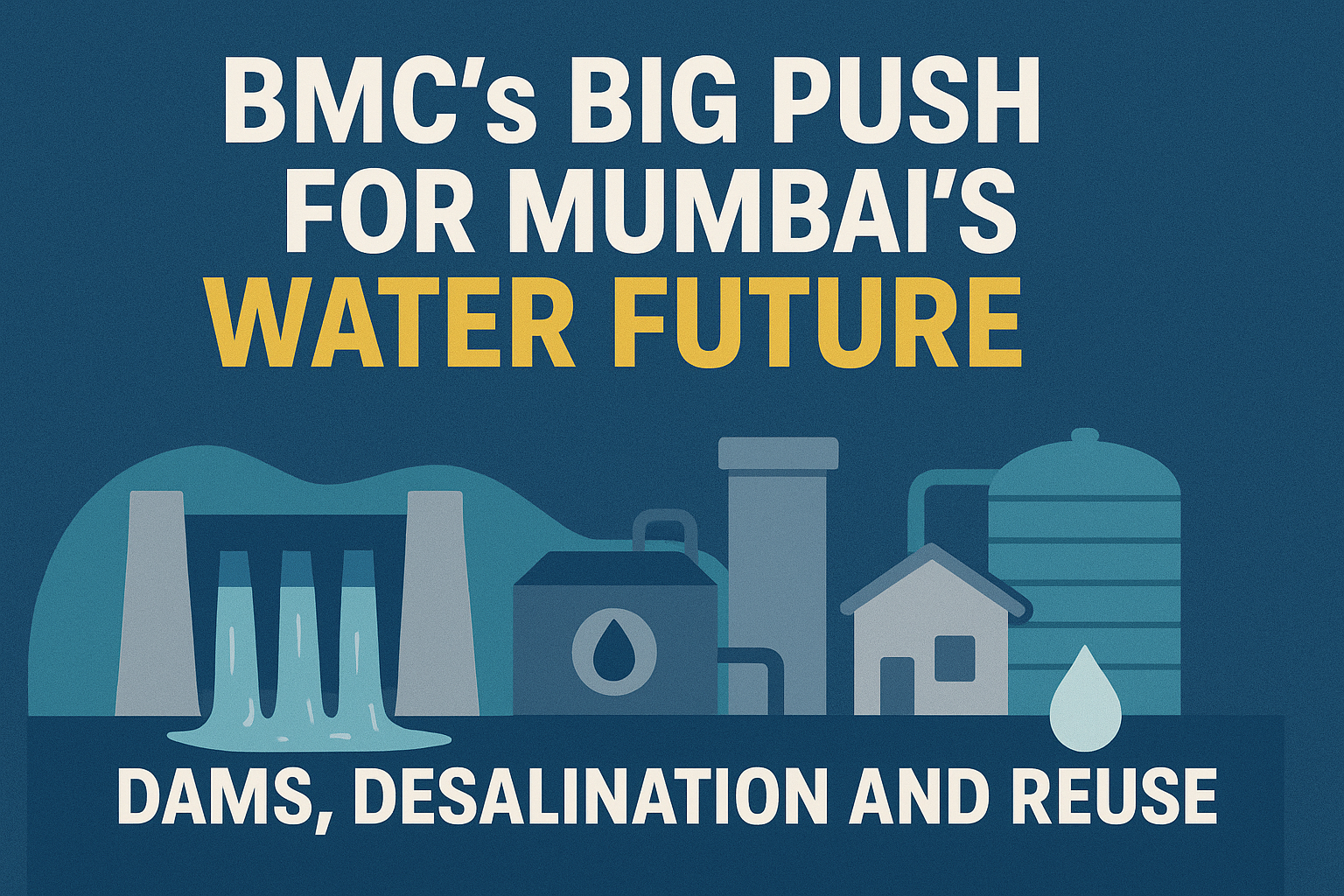
BMC’s Big Push for Mumbai’s Water Future: Dams, Desalination and Reuse
Mumbai, the city that never sleeps, also happens to be a city that never stops drinking water. Every morning when taps come alive across the metropolis, few people pause to think about the complex journey of those water droplets. Behind the scenes, the Brihanmumbai Municipal Corporation (BMC) runs one of the country’s most intricate water supply systems—quietly ensuring that nearly 4,000 million litres of water (MLD) reach homes and businesses daily.
But with Mumbai’s demand already outpacing supply and projected to grow sharply in the coming decades, the civic body is charting an ambitious expansion strategy involving new dams, desalination plants, and advanced water reuse projects.
A Mammoth System at Work
Mumbai’s water originates from a network of seven lakes. Tulsi and Vihar lie within city limits, but the bulk of supply comes from distant reservoirs like Modak Sagar, Tansa, Bhatsa, and the Vaitarna lakes, some nearly 175 km away. This water travels through 650 km of transmission mains and 5,500 km of pipelines before being treated at massive facilities like the Bhandup Complex—the largest water treatment plant in Asia.
From there, 27 reservoirs and thousands of “chaviwalas,” or valve operators, take charge, ensuring supply across localities for two to six hours a day. Affluent societies manage with stored water, while many slum dwellers rely on shared taps and tankers. It’s a system that demands precision and dedication every single day.
The Challenge Ahead
Currently, Mumbai consumes around 4,463 MLD against a supply capacity of 4,000 MLD. This gap is only expected to widen—demand is projected to hit 6,535 MLD by 2041. With an annual requirement of nearly 14.5 lakh million litres, the BMC cannot rely on lakes alone.
The civic body has already initiated a series of long-term projects to meet this demand. Central to this plan are three major dams—Gargai, Pinjal, and the Damanganga-Pinjal river-linking project—which together will add over 2,400 MLD. The Gargai dam in Palghar alone will contribute 440 MLD when complete.
Turning to the Sea and Sewers
In addition to dams, BMC is betting on non-traditional sources. A 200 MLD desalination plant, proposed at Manori and Versova, will convert seawater into potable water. If successful, it would become Mumbai’s first large-scale desalination project, following similar efforts in Tamil Nadu.
Equally important are upgrades to sewage treatment plants (STPs). At present, most sewage undergoes only primary treatment before being released into water bodies. The BMC’s plan to upgrade seven STPs will create a capacity of 2,464 MLD, with half of this treated water reaching near-potable standards for reuse. About 1,232 MLD of high-quality recycled water will be diverted for non-drinking purposes like gardens, toilets, depots, and even industrial use.
This approach serves a double purpose: conserving freshwater and ensuring sustainable urban growth. Already, the Colaba STP supplies recycled water at highly subsidised rates to institutions like the Navy and Wellington Club, a model that may soon expand citywide.
Affordability and Policy Innovations
Mumbai is among the few metros in India where water remains remarkably affordable. Residents pay just ₹6 per 1,000 litres, while commercial users pay ₹50. Compare this with the real cost of sourcing, treating, and transporting water, and it becomes clear that BMC subsidises heavily to keep water accessible.
The civic body has also taken steps to ensure equity. Its “Water to All” policy, launched in 2022, extends water supply to unmapped slums on both public and private land. By March 2025, nearly 15,000 new connections had been installed under the scheme, offering legal water access to many who previously depended on illegal or irregular sources.
Hurdles Along the Way
Despite the achievements, challenges remain. Between January and June 2025 alone, over 14,000 complaints of leakage were recorded. Theft and illegal tapping also contribute to water losses. Compounding these issues is a severe manpower shortage. Out of 8,448 sanctioned posts in the water department, 3,600 remain vacant, including critical positions such as engineers and sluicemen.
Maintaining the vast pipeline network is another daunting task. Much of it runs underground through forests and remote areas, making monitoring difficult. Factors like soil erosion, silt, and chemical exposure accelerate corrosion, leading to frequent leaks.
Citizens’ Role in Conservation
Experts stress that while BMC is pushing boundaries with mega-projects, citizens also need to step up. Studies suggest that nearly 60% of potable water in Mumbai is used for non-essential activities such as cleaning and washing. Reducing wastage and adopting recycled water where possible could significantly ease pressure on the system.
Vinod Gholap, president of the Fight for Right Foundation, summed it up well: “It’s easy to criticise, but the BMC’s water supply network—drawing water from dams and delivering it directly to our taps in drinkable form—is truly impressive. As citizens, we must also recognise our responsibilities and avoid wasting water.”
Looking Ahead
BMC’s forward-looking projects, whether the colossal Damanganga-Pinjal link or the futuristic desalination plants, underline the civic body’s determination to secure Mumbai’s water future. At the same time, the push for recycling and conservation ensures that sustainability remains central to the plan.
As Additional Municipal Commissioner Abhijeet Bangar noted, the water department works “round the clock, often under severe pressure, yet ensures uninterrupted supply.” While much remains to be done, Mumbai’s story of water management stands as an example of how a megacity can innovate, adapt, and prepare for the future—one drop at a time.
